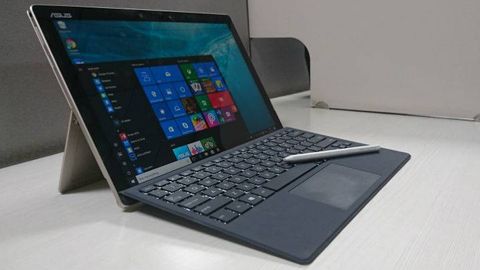TechRadar Verdict
A great 2-in-1 laptop with a brilliant display and oodles of power which is sadly outgunned by the competition and has poor battery life.
Pros
- +
Brilliant 3K display
- +
Immaculate design
- +
Powerful Core i7 processor
- +
Built in kickstand
- +
Decent Keyboard
Cons
- -
Poor battery life
- -
Trackpad is a bit iffy
- -
Buggy Stylus
- -
Fans get very loud
Why you can trust TechRadar
Design 4/5
Features 4/5
Performance 4/5
Usability 3.5/5
Value 3.5/5
The Asus Transformer 3 Pro is a very capable 2-in-1 laptop which is named squarely to compete with Microsoft’s Surface Pro 4.
It has power packed internals, a gorgeous 3K display and a decent keyboard/touchpad cover. Is it good enough to beat the segment best? let’s find out!
Design
From a distance, you will forgive for mistaking the Transformer Pro 3 for the Surface Pro 3. When it comes to inspiration, you cannot choose a better muse than the Surface Pro.
The device is gorgeous. The chassis is crafted from aluminum-magnesium alloy and is alarmingly thin at just 8.35 mm. (Just a few years ago, the iPhone 4 was 9.9mm thin and that was considered amazing!). It weights just under 800 grams, which makes it very portable. As a tablet though, it still seems a tad too heavy after prolonged use.
Asus claims that the aluminum-magnesium alloy is an incredibly tough material which helps protect the device from everyday scuffs and scratches.What is ironic though is the fact that our review unit came with several scratches and scuffs all across the back panel of the tablet.

The Surface Pro comparisons don't just end with the look of the device. Just like the Surface, the Transformer also comes with an in built Kickstand which in integrated into the back of the device. The hinge on the kickstand is just not very confidence inspiring and the first time I opened it, I couldn't help but think how much sturdier the hinge of the Surface Pro is.
The Transformer Pro 3 comes in two colors, Icicle Gold and high-tech Titanium Gray, with our review unit being the former.
There’s no denying that the device looks amazing. It is sure to steal second glances from people and is also built incredibly well. It’s sleek, suave and classy and is a plus point for the device. However, Asus forces me to compare it to the Surface Pro with the design choices it has made and in that regard, the Surface Pro looks even better.
Display
The Transformer Pro 3 has a 12.6-inch 3K display with an incredible resolution of 2880x1920. It has a color gamut of 121% sRGB and 85% NTSC and a viewing angle of 178 degrees.
Technical jargon aside, the display is by far the best characteristic of the device. It is incredibly sharp, has great viewing angles and incredible colors. In short, it looks simply gorgeous.
One big complaint with the display however is that fact that it is insanely reflective. As a result the sunlight legibility is poor and it becomes a very expensive mirror when out in blazing sun.
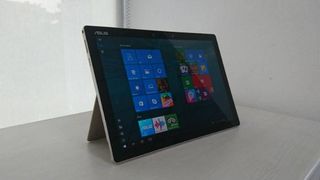
Being a 2-in-1, it of course comes with a multi-touch touchscreen which is a delight to use. The fact that Windows 10 is poorly optimised for touch is another story altogether.
This is 2016, and still Windows has so many scaling errors. Text and icons in certain locations of the operating system look incredibly jagged and low res. In the process of scaling to a resolution this high, the touch points become too small and it is jarring to see low res text in a sea of crisp ultra high res content.
All in all, the display is sharp, gorgeous and a treat to use. Seriously, seeing 2k content on the Transformer 3 Pro is just a pleasure.
Keyboard/Touchpad
A writer by profession, the Keyboard is one of the most important aspects of any laptop for me. The keyboard cover for the Asus Transformer 3 Pro is adequate, if not that great.
The keys are surprisingly full-sized and are spaced apart well enough for there to be no mis-hits while typing. However, as is the case with most keyboard covers, Surface included, the key travel and feedback is very mushy and not that great.
I tried writing this whole review using the keyboard cover, but had to give up halfway in as it was becoming too much of a chore.
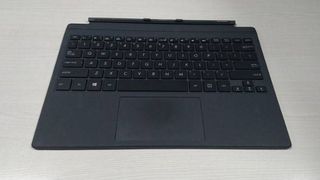
Nitpicking aside, for a keyboard cover, Asus has done quite a good job here and it’s good enough for everyday use. Yes, you won’t be composing the next Harry Potter on this keyboard, but it’s good enough for the occasional note and web use. And yes, the keyboard is backlit, so brownie points for that!
The trackpad on the other hand i didn't like very much to be honest. It’s adequate for light use, but for anything precise i would recommend an external mouse. To be fair to Asus, I do think that the trackpad is a little better than the puny one found on the Surface Pro and is very smooth.
Windows laptops have been trying to perfect the touchpad for years but still cannot come close to Apple’s gorgeous trackpad on the MacBook. Gestures are iffy, with both Windows 10 and the trackpad to blame here. The accuracy rate is just not there.
Gestures aside, the trackpad is good enough for day to day use, but any precision work will require an external mouse.
Also read : Asus ZenBook 3 review: Compact Powerhouse
Hardware/Performance
Asus has packed everything but the kitchen sink in the Transformer Pro 3.
It comes with Intel’s latest generation Core i7/Core i5 processors, upto 16GB of DDR3 2133 MHz RAM, upto 1TB of PCIex4 Gen 3 SSD and Intel HD Graphics 620. All this culminates in a laptop (tablet?) that is blazingly fast.
Asus claims that the PCle SSD is three times faster than normal SSDs.
The laptop boots up in seconds and shuts down instantaneously and powers through day to day tasks easily.. Whilst using it as my daily driver, there was a time when I had over 30 tabs open in Chrome, several Word windows open and was using Photoshop to edit pictures and it handled it like a champ.

Like the Surface Pro, what makes the Transformer 3 Pro stand out from all tablets and cheaper 2-in-1’s is the fact that it can also be used for intensive productive work. It’s a delight having a machine which is so portable but at the same time also extremely powerful. Unlike the compromise that is the iPad Pro or the 12-inch MacBook, the Transformer 3 Pro can actually get WORK done.
What really surprised me is the fact that the Transformer 3 Pro doesn't heat up much even while doing intensive tasks like editing photos and videos. Although the fans are loud, very very loud, which can get rather irritating at times.
The Transformer 3 Pro also comes with the ability to add desktop grade graphics which are a welcome addition in such a svelte package. You can add upto an NVIDIA GeForceGTX 980 GPU via Thunderbolt 3, which can greatly enhance the graphic capability of the device and even make it VR ready.
How does it work as a tablet?
The Transformer Pro 3 has a nifty kickstand at the back, which is more than a little inspired from the Surface Pro. This is a recurring theme with the Transformer as it feels a lot like Asus’s version of the Surface Pro than a completely new device.
It is quite hefty but still comfortable enough for light periods of use as a tablet. The touchscreen is very responsive and as mentioned before, the display is just gorgeous.
The problem here doesn't lie with the laptop itself but with Windows 10. Windows 10 is just not optimised well for tablet use. Everytime I took the keyboard dock out, it surprised me as to how much it crippled the device’s usage.

The Windows 10 store is sparse, to say the least. There are several major apps lacking such as all Google Apps. Let’s take a scenario here. What are tablets used most for? Browsing the web and confusing multimedia content. Well, the Edge browser is okay, but still not optimised very well. And using any other desktop browser such as Chrome or Firefox is a nightmare in tablet mode.
All touch targets are too small, the scrolling is very patchy and so on and so forth. Now let’s tackle multimedia. There’s no YouTube app on the Windows 10 store. Now you might say why don't i just open YouTube on the browser?
Because on the browser again the experience is optimised for use with a mouse and keyboard and not touch. It’s just not as smooth an experience as using the official YouTube app on an Android tablet or iPad.
This takes us nicely to the Stylus.
The Stylus: Asus Pen
Apple makes the Pencil. So Asus decided to make a Pen. In all seriousness, the experience offered by the Asus Pen is a mixed bag.
It offers upto 1,024 levels of pressure sensitivity and comes with two buttons, one of which acts as a right click button and the other one is an eraser.
The Stylus glides nicely over the screen and is very smooth and offers great levels of pressure sensitivity. The Stylus does add to the experience considerably and I found myself using it to jot down notes occasionally. The eraser is a nifty tool to have at your disposal, especially when you're doodling over web pages using Microsoft Edge.
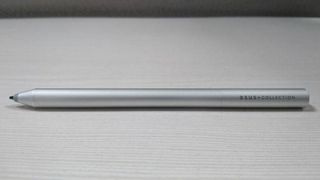
The problem is with the right click button. It might be a glitch with our unit, but the button is very temperamental and seems to have a mind of its own. Sometimes it initiates a right click successfully, sometimes it doesn't.
Additionally, another thing takes away from the experience quite a bit is the fact that there is provision to store the Stylus at all. No magnet like the Surface Pro, no clasp, no holder, not even the cheap strap that the Surface Keyboard offers where you can slide the Stylus in.
Be prepare to buy new Stylus’s every few months as and when you eventually lose the one that came with the device.
Connectivity
This is where the Transformer Pro 3 shines in comparison to its brother the ZenBook 3 which eschewed all ports in favour of the USB C port and 1 headphone jack.
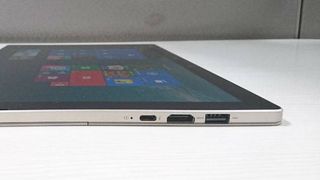
Apple is on a mission to ditch as many legacy ports as possible. It has ditched every I/O expect USB C entirely from its MacBook Pro and the 2015 MacBook, and I’m glad Asus has decided to take a different route.
It comes with a USB C port, a USB 3.0 port, and a microSD port. While not as many ports as a conventional laptop, this is still far better than having just one I/O port and having to pack a multitude of adapters.
Battery Life
The Battery life of the Transfer Pro 3 is average at best. This is where the laptop really lets you down.
The performance is stellar, everything runs as smooth as butter. The only problem is that it doesn't run for long. In a way, the power packed internals really affect the battery life badly.
Push the laptop and the battery drains itself in 3 hours flat. The Surface pro 4 has much better endurance, it can easily last you 5-6 hours of intensive use.
Simple day to day use, with just a few tabs open on Edge, the brightness set at 50% and the Transformer Pro gives up the ghost in around six hours. In the day age of MacBooks having all day 10 hours battery life, 4-5 hours is just not acceptable.
On a positive note, it does come with fast charging support and can charge itself up to 60% in about an hour.
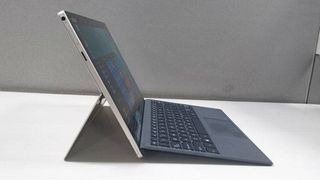
Price/Verdict
The Asus Transformer 3 Pro will be available in retail stores from January 2017 sporting a starting price of Rs. 1,10,990 for the Core i5 variant.
One one hand, the device packs incredibly powerful internals in a very slim frame which can be used both as a tablet and a laptop. It has an absolutely brilliant display, great multi-touch capabilities and a decent keyboard cover.
On the other, the battery life is rather poor, the fans kick in with minimal usage and are very loud. Additionally, the keyboard is not suitable for long typing sessions and the stylus is a bit buggy.
Is it better than the Surface Pro 4?
Well, No. The kickstand does not exude confidence, the stylus is buggy, the keyboard dock is average and the fans are very loud.
But it is quite cheaper. The top of the line variant with Core i7, 16GB RAM, 512GB SSD is priced at Rs 1,44,990. A comparably specced variant of the Surface Pro 4 will set you back around Rs 1,97,000, giving the Transformer a pricing edge.
Also read : HP Spectre review: Crafted to perfection
Features Writer at NDTV Gadgets 360. Past - Sub Editor at India Today Tech, Content Writer at TechRadar India. A PG diploma holder in English Journalism from IIMC, New Delhi. Avid tech enthusiast, cinema buff, voracious reader and Formula 1 fanatic.
